|
No other product
in history has taken humiliation, destruction and poverty
and made them the stuff of dreams. The Vespa, the original
and best Italian motorino(scooter) has just turned 60, and
despite 20,000 mechanical changes, 120 different models and
total sales of more than 16 million, it is still
recognisably the same machine as the one that made its debut
in April 1946.
Inside, though,
everything has changed: the old two-stroke engine, as
responsive and peppy as it was noisy and polluting, has
given way to a clean, quiet four stroke; the transmission is
automatic. But the look is essentially unchanged. For one
new model, the makers are even putting the headlamp back on
the mudguard, as it was on the original. They can't tamper
with the look too much - they can only tease and titivate
it, adding leather seats, fiddling with the shape of the
handlebars - because the Vespa is much more than just
another two-wheeler: In one clean, sleek piece of machinery
it says Italy, with all the sweet connotations that word has
acquired: sunshine, speed, voluptuous olive-skinned women,
casually impeccable men. It says Gregory Peck and Audrey
Hepburn, breezing through the city in Roman Holiday. More
than the Mini, the Jaguar, the Aston Martin or the Ferrari,
the Vespa is the ultimate cool machine.
But is also, in
much of the world, the poor man's saloon car, the simplest
and cheapest family vehicle. What the sit-up-and-beg bicycle
was in Mao's China, the Vespa was, and to a large degree
remains, in the teeming cities of India, carrying husband,
wife, nursing baby, two children and luggage on family
excursions. When the Vespa came into being, Italy, too, was
a poor country. Enrico Piaggio, the son of the founder of
the company of the same name, was an aeroplane builder. His
designer, Corradino D'Ascanio, was an aeronautical designer
who built the first modern helicopter. But in the spring of
1946, ravaged by war and invasion, this country did not need
more planes and helicopters. Italy needed to get out of the
rubble of its bombed cities and on to the potholed road. The
country had no money and no work, no place to go and nothing
to do when it got there, and its whole future to invent from
scratch. The Vespa was the product of desperation, and the
answer to desperation.
One reason it
did so well, from the day it launched, was that it was the
ultimate anti-motorcycle motorcycle. What makes motorbikes
irresistible to the minority of the population that finds
them so is precisely what makes them obnoxious to everybody
else. They are intimidating, noisy and dangerous looking.
They go much too fast. You have to lie almost flat to ride
them, wearing heavy protective clothing, and you look as if
you are going to die. It is almost impossible to ride them
and not get dirty. Piaggio's good fortune was that Corradino
D'Ascanio belonged to that segment of the population that
really hates motorbikes. So he produced a two-wheeler
radically different from any that had been previously
thought of, as if the classic motorcycle had never existed.
Yet if Piaggio
had given the nod to D'Ascanio's last prototype but one, the
whole project might have sunk without trace - and Italy's
reputation for elegance, style, sexiness etc with it.
Because that prototype, the MP5, stank. It was nicknamed "Paperino",
the Italian for Donald Duck, because of its ugliness. The
fundamental ideas of the scooter were already present, the
notion of hiding the engine and protecting the rider behind
a curving sweep of steel that culminates in the handlebars.
But a crucial final step had yet to be taken: the engine's
bulk was still throbbing between the rider's splayed legs.
Piaggio told D'Ascanio to have another try.
With the MP6,
the breakthrough was achieved. D'Ascanio slices out the
engine, as if with a sweep of a butter knife, and banishes
it to the hubs of the back wheel where it sits like a
bulbous growth either side of the chassis. Nothing but air
separates the seat and the handlebars, and the rider can
place his or her feet on the spacious, empty platform with
knees together as if sitting at the table of a cafe eating a
gelato.
|
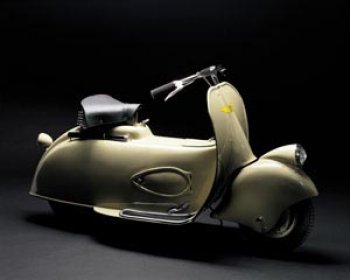 |
|
The
Vespa MP5 was nicknamed "Paperino",
the Italian for Donald Duck, because of its ugliness. The
fundamental ideas of the scooter were already present, the
notion of hiding the engine and protecting the rider behind
a curving sweep of steel that culminates in the handlebars.
But a crucial final step had yet to be taken: the engine's
bulk was still throbbing between the rider's splayed legs. |
|
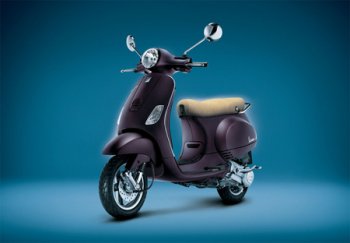 |
|
The Vespa's extraordinary
longevity - it has far
outstripped other cult motoring
object such as the Mini and the
Beetle - owes much to its
revolutionary design; but also
to Italian cities, many of which
are impossible to negotiate by
any other means. |
|
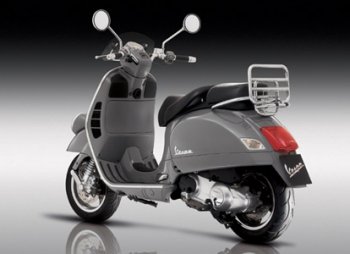 |
|
Piaggio have celebrated
the 60th anniversary of the Vespa scooter by
introducing the special GT-60 model. |
|
|
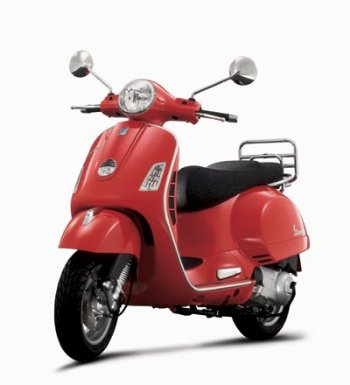 |
|
No other product
in history has taken humiliation, destruction and poverty
and made them the stuff of dreams. The Vespa, the original
and best Italian motorino(scooter) has just turned 60, and
despite 20,000 mechanical changes, 120 different models and
total sales of more than 16 million, it is still
recognisably the same machine as the one that made its debut
in April 1946. |
|
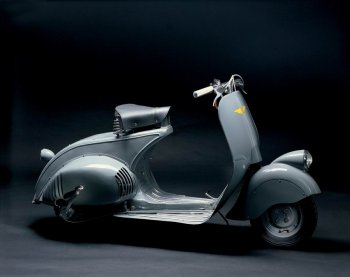 |
|
Piaggio took one look at the MP6, with its bulbous
yet aerodynamically curving engine housing and
exclaimed: "Sembra una vespa!" -
"It looks like a wasp!" The name
stuck, and was soon being
applied to the infernal whining
of the machine's two-stroke
engine as the swarms took over
Italy's cobbled lanes. |
|
|
Piaggio took one look at that
revolutionary design, with the
bulbous yet aerodynamically
curving engine housing and
exclaimed: "Sembra una vespa!" -
"It looks like a wasp!" The name
stuck, and was soon being
applied to the infernal whining
of the machine's two-stroke
engine as the swarms took over
Italy's cobbled lanes.
The 1950s were the beginning of
the heyday of the Vespa: one
million scooters were produced
in its first decade, and
factories opened in Britain,
Germany, France, Belgium, Spain,
Indonesia and India as well as
Italy.
Italy's transformation from a
picturesque but rather
ridiculous place, the home of
spaghetti and Fascism, to the
epitome of Mediterranean chic,
was well under way. It was
incarnated in figures such as
Gianni Agnelli, the elegant boss
of Fiat, who had A-list friends
across the world; in products
such as the Olivetti typewriter
and modern Italian furniture; in
the burgeoning film industry and
its extraordinary directors,
Fellini, Pasolini, Visconti. But
nothing captured the spirit of
that transformation better than
the Vespa.
It epitomised the way that - in
the teeth of American cultural
hegemony and although profoundly
influenced by America - Italy
managed to plot its own postwar
course, to create its own icons
of style. American cars sprouted
absurd fins and ballooned ever
larger. Yet no American in a
Chevy ever looked cooler than
Gregory Peck squiring his
princess past the Coliseum on
the Vespa. That was 1953, and
sales of the machine went
through the roof. And American
celebrities came flocking.
Marlon Brando, Ben Hur director
William Wyler, Charlton Heston
and John Wayne were among the
Americans who succumbed.
It was on the coat tails of
Roman Holiday that the Vespa
charisma crossed the Channel
and, in the mid-60s, became the
defining element in the Bank
Holiday wars between Mods and
Rockers. The Rockers, like the
Hells Angels they anticipated,
were greasy, dirty and hairy;
obviously trouble. The Mods were
more ambiguous; nicely turned
out in their Fred Perry sports
shirts and tight-fitting,
three-button, Italian-style
suits, sharp hair cuts and these
domesticated Italian
two-wheelers. But they were no
pushovers. They listened to ska
and soul music, the Action and
the Who; they took pep pills and
fought the Rockers on the sands
of Margate and Brighton with
chains and flicknives. They did
what no Italian would have
thought of and loaded their
Vespas with mirrors and
redundant waving antennas. With
Mafia chic somewhere in the mix,
the Mods reinvented the Vespa as
a war machine. They took it as
far as it would go. But they
couldn't kill it off.
Mods morphed into skinheads and
some of them still rode
scooters, but the Vespa on the
Italian cobbles - with stucco
and marble, wisteria and
umbrella pines in the background
- sailed on regardless.
The Eighties was the most
difficult decade for the Vespa,
because it signalled the arrival
of the Japanese. But thanks to a
mixture of protectionism and
patriotism, the Vespa did not
suffer the fate of Britain's
bike brands. Italy's roads today
are full of Yamahas, Hondas and
Suzukis, but the Vespas hold
their own: Piaggio, the company,
has refused to concede the
fight, bringing in supercharged
models while keeping the retro
market fully supplied. After
being banned from the US in the
1980s because the dirty
two-stroke engines failed to
meet emission standards, it has
returned with cleaner
four-stroke models.
Further developments are in the
offing. Piaggio tested a
zero-emission,
hydrogen-fuel-cell scooter this
year. The company's president,
Roberto Colaninno, said "On 11
May, at Campidoglio in Rome, we
will present Vespa with a
brilliant heir. We are talking
about a real revolution." Rumour
has it that Piaggio will unveil
the first Vespa three-wheeler.
The Vespa's extraordinary
longevity - it has far
outstripped other cult motoring
object such as the Mini and the
Beetle - owes much to its
revolutionary design; but also
to Italian cities, many of which
are impossible to negotiate by
any other means. There is
nowhere to park a car, even if
one has the patience to sit out
the interminable snarl-ups. In
ancient cities such as Rome, the
building of new subway lines is
permanently embroiled in
financial and archeological
challenges. The bicycle is only
for those with unusual courage.
The scooter, however is just
right.
Report courtesy of
The
Independent
|
|
|
|
![]()
![]()